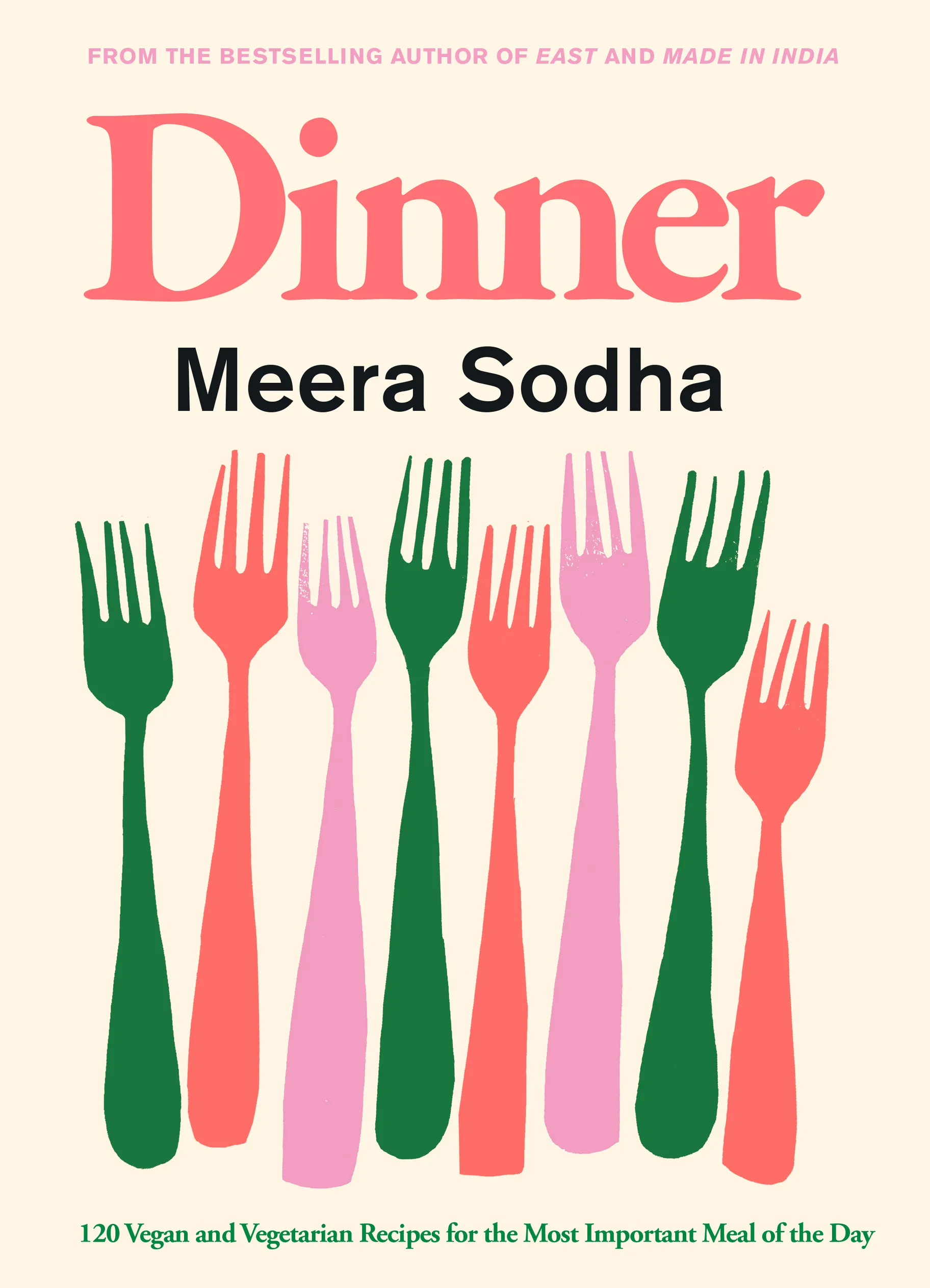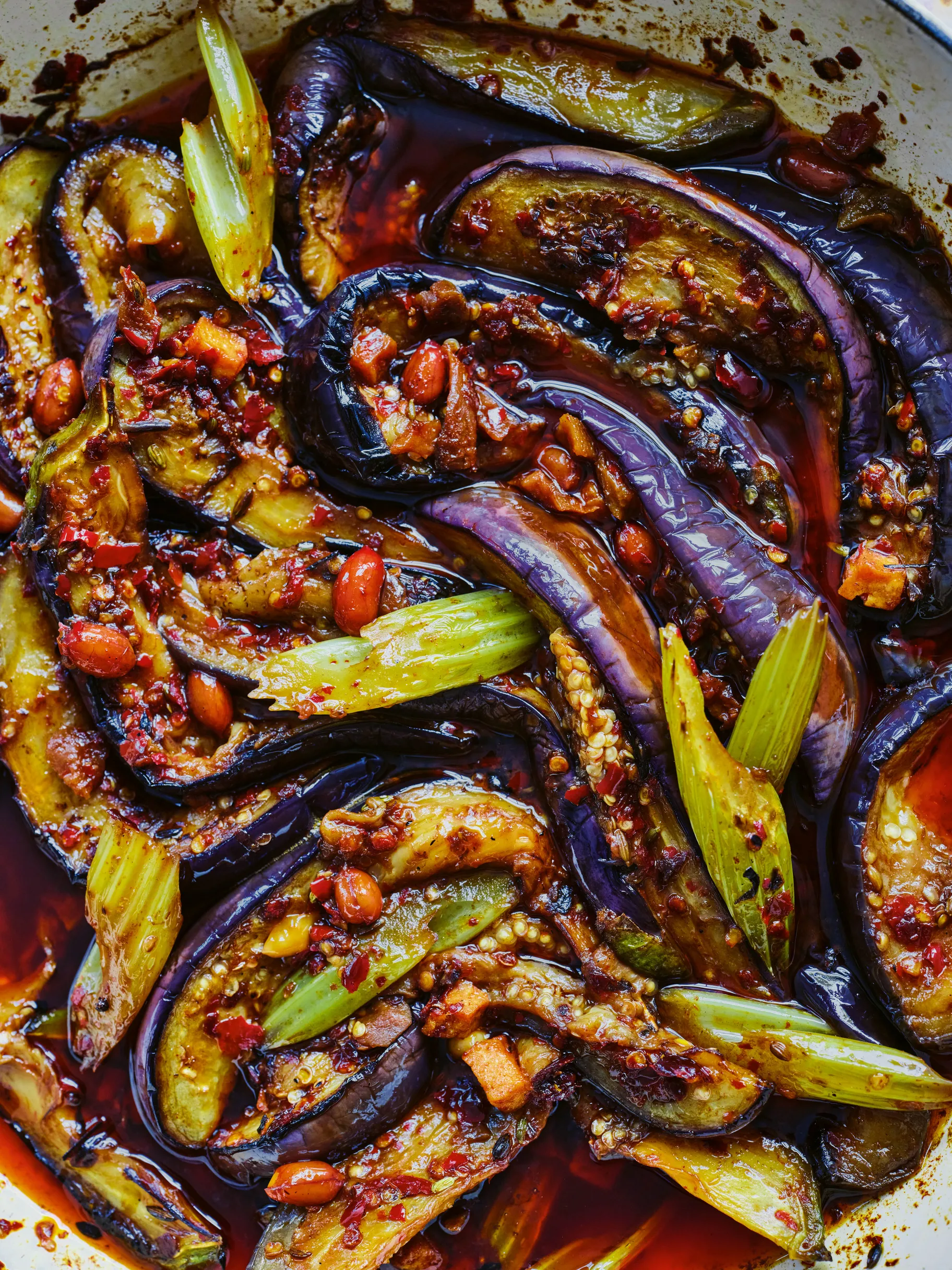What’s for dinner? It’s a question that can stir excitement or dread. For cookbook author Meera Sodha, developing recipes became arduous and she lost her initial enthusiasm. Cooking and shopping began to feel like a burden, and eventually she burned out. In her latest book, Dinner: 120 Vegan and Vegetarian Recipes for the Most Important Meal of the Day, she describes how she got her groove back and shares a raft of veggie-centric recipes that brought her back to the stove.
Evan Kleiman: I think this burnout is so relatable for all of us. What was the meal that caused you to snap out of your funk and get back into the kitchen?
Meera Sodha: I probably hadn’t cooked in months and months, like maybe about 6, 7, 8 months. My husband, he was doing all of the cooking and one night, he asked me if I might cook him a meal. This wasn’t him saying, “Please cook for me, I’m hungry.” It was him saying, “Please take care of me because I’m struggling here.” He was looking after our two daughters and cooking all the family meals. And he’d been looking after me and that had been going on and on and on.
I just ran into the store cupboard and I made a Malaysian dal. I picked up some lentils from the store cupboard. I had a tin of tomatoes and a tin of coconut milk, all of these pantry items and spices in the fridge, in the freezer section. I keep my aromatics like makrut lime leaves and lemongrass and I just made a Malaysian dal. Now it’s a dal but it’s a very aromatic dal, and it’s something that Hugh and I ate bucketfuls of when we were traveling in Singapore in 2019.
I don’t know why I made that particular dish. I think we both love it. It was very easy. I find dal very, very soothing. I think the thing is, the snapping out of, like you said, I realized when I was cooking it, unlike many times before, when I tried to cook and I just couldn’t, and I just felt exhausted all the time, I felt there’s energy and life flowing back into my fingertips, and the blood sort of running around my body, and my lungs feeling full of air again. I thought there’s something different here. I think it’s because I’ve really enjoyed cooking this, and I’m doing it out of love, and there’s a different purpose to it, and perhaps it’s not work.

“I felt there’s energy and life flowing back into my fingertips,” says Meera Sodha, describing how she rediscovered her love of cooking. Photo by David Loftus.
I can really relate to that period you had where you were sort of in a slough of despond related to food. I know that for me, sometimes an ingredient can be the thing that nudges me out of either a cooking rut or that lessened desire to start to touch things. When I saw that your first chapter is devoted entirely to eggplant, I feel like it might be the same for you. I love eggplant but I think it continues to be, I don’t want to say underrated, but I think it can be divisive. I think people don’t know how to cook it well. Why did you want to open the book with this ingredient?
I love eggplant. I think it is underrated. It might be underrated because I’m not sure if people know exactly how to treat their eggplants and how to get the best out of them. I think the reason why they’re so fantastic is because, if you’re straddling this world where you eat some meat but you’re looking to eat more vegetarian food, they are unbelievably satisfying. I call them shape shifters because I think they can mutate from being quite meaty to creamy to spongy. They’ve got it all going on, and the texture can change so much.
But you asked me why I decided to open the book with them, and actually, I’m going to tell you something, which is that I was actually going from A to Z with my vegetables in the UK. Aubergine, it obviously begins with A. We had such a difficult time trying to work out what to do because it’s the only vegetable that we had to change in the contents to something that wasn’t alphabetically sound. But we decided to keep the structure anyway.
That’s not to say that they aren’t a great opener. I think actually what you choose to open a cookbook with is very important. I learned this from my old art director. He said, “Listen, stop writing all your fancy lists of equipment and what ingredients people should have in your recipe book. You’ve got 10 seconds to sell this book to people when they’re in a bookshop. Make sure that you’re into the food straight away, and the food looks great and really inviting.” I thought, ah, okay. And eggplants for me, do that.
I love all of that so much. You have one recipe in the book that looks so simple, and it includes another underrated vegetable, celery, which may be one of my top three favorite vegetables. You’ve titled it Ben Benton Strikes Again. Who is Ben Benton? What makes this recipe a hit?
Ben Benton is a really good friend of mine, and we used to work in a restaurant together. My stint in restaurants was very brief. I’m really a home cook now. He is my friend. And maybe everybody has this sort of friend that when you are stuck in a rut and you’re thinking, gosh, what shall I make? I always ask Ben because he’s guaranteed to be making something utterly delicious that’s also quite simple but always greater than the sum of its parts.
He told me about this dish. It’s got eight ingredients, and it’s braised aubergine wedges and celery. I don’t love celery, I’ve got to say, when it’s fresh, but when it’s braised, I think it’s like a sort of angry cat that turns into a purring, pretty cat. It becomes mild and soft and sweet and aromatic and delicious. I really love this dish and when people say, “What should I cook from your new book?” I was like, “Make Ben Benton Strikes Again,” because all you’re doing is braising the celery and the aubergines in some soy sauce, some rice vinegar, and a genius ingredient that I know you’ll know.
Actually, despite my great love and addiction for Lao Gan Ma chili crisp, I have never heard of this ingredient, so tell us about it.
So it is chili crisp, but the company that makes it, Lao Gan Ma, has a variety of different chili crisps. The one that Ben uses is particularly nice. It’s got chunks of kohlrabi, peanuts, and tofu in it. Just think of it as more textured and more interesting than your average chili crisp. But also, as a single ingredient, it’s brilliant, because you just chuck 40 tablespoons of this stuff into the braise, and then suddenly you’ve got tofu and peanuts and kohlrabi. And you have the chili crisp, and you have this lovely, oily, zingy, umami-ness going on.
This is my favorite way to eat eggplant — to fry it first. The key to getting that delicious unctuous texture is to remove as much moisture as possible. So you fry it, and then once you’ve fried it and you’ve evaporated a lot of the water, then you can chuck as much flavor as you want because by this point, it’s super creamy and a little bit chewy and delicious and very, very soft. And then it’s ready to receive whatever flavor you want to throw at it.

“Dinner” by Meera Sodha offers flavorful, vegetable-centric dishes for home cooks. Photo by David Loftus.
So delicious and very beautiful as well.
Thank you.
One of my go-to dinners is a broccoli pasta in which I cook the broccoli with garlic and chili pepper until it completely falls apart. You do a broccoli pasta as well but your technique is completely different as is the flavor profile. Can you describe how you put together the broccoli Spaghetti Le Zhoug?
Each family must have vegetables that they cook or they buy week in, week out. We always have a head of broccoli in our fridge. What I do is basically blitz the broccoli in a food processor, so it turns into almost a rice or a mince. You could do it either way, actually, now that I think about it. This could have been cooked in the way that you described, where you cut the broccoli and you cook it until soft, and then you blitz it.
I think your way gives you a much prettier color.
That could be the salt. So blitz the broccoli, add a half a teaspoon of salt, and then just cook it in a pan until it becomes sweet and soft. Then what I do is add some zhoug. Zhoug is made sort of a fresh coriander or herb sauce that’s quite spicy. I make it with jalapenos, cumin, ground coriander, cardamom, lemon juice, and oil. So again, you’re using the food processor just to be able to whip up this lovely, herby, sprightly, zingy sauce, and it’s all green. And before you know it, you’ve eaten a whole head of broccoli.
I, too, am one of those people who every single time I go to the market, I get broccoli. Then sometimes I use it up right away, and sometimes I forget it’s there. So it’s good to have this dish in your back pocket. Can you leave us with something sweet?
Matcha is all the rage right now. It seems to be going crazy.
It is crazy.
It is crazy. So maybe we shouldn’t recommend matcha because there’s so much matcha. But if you are going through the matcha craze, I would recommend the matcha mochi cakes. I love the mochi cakes, and I make them as small cupcakes, because I love that crunch around the outside to the chewiness inside ratio, rather than making a big matcha cake. You can pretty much make it in a bowl.
But if you are experiencing some heat and you would like something cold, then I’m going to recommend the bubble tea ice cream. You can buy these instant boba balls. There’s two different types of boba balls that you can buy but these are the quick ones, and this is my cheats pudding. I buy really good quality ice cream, and I make a really super quick syrup with black tea bags and sugar, and make the boba balls, which you boil in five minutes. Then you can just have this lovely bubble tea ice cream. You put the syrup in and the boba balls and the ice cream. If you let it melt, it turns into just this gorgeous tea-flavored ice cream that I love. That’s one of my favorite things to do, and also, because I’m quite lazy in the summer with cooking.

Named after a friend of Meera Sodha’s, Ben Benton Strikes Again is essentially braised aubergine and celery. Photo by David Loftus.
Ben Benton Strikes Again
Serves 4
Prep Time: 10 minutes • Cooking Time: 35 minutes
On any given day, I want to know what my friend the cook and writer Ben Benton is eating, because it’s guaranteed to be great. I’ve never met a more naturally talented cook who has the ability to transform the most basic ingredients into pure magic. He has many fans of his ben ben noodles (published in East), and here he strikes again with a braised eggplant and celery dish that he likes to make for friends when they come for dinner. It does not disappoint; elegant and simple, it’s greater than the sum of its parts.
NOTE* You’ll need a specific type of Lao Gan Ma chilli oil to make this, called “kohlrabi, peanuts and tofu in chilli oil.” If you use another type, add it a tablespoon at a time until it tastes just right to you.
Ingredients
2 tsp Sichuan peppercorns
3 medium eggplants (2 lbs)
canola oil, for pan-frying
2 stalks of celery (10 oz), cut at a steep angle into ¾-inch pieces, any leaves reserved
1 tsp fennel seeds
2 tbsp light soy sauce
2 tbsp rice vinegar
1/4 cup Lao Gan Ma kohlrabi, peanuts, and tofu in chilli oil cooked jasmine rice (p 304)
Instructions
Lightly bash the peppercorns in a mortar – or skip this step if you’re happy (as I am) to encounter a feisty little crunch in the finished dish.
Cut the eggplants in half lengthways, then cut each half into four long wedges. You’ll be frying them in batches, so get a plate and a pair of tongs ready to move them around.
Put 2 tablespoons of oil into a wide nonstick pan or pot for which you have a lid over a medium to high heat.
When it’s shimmering hot, place the wedges of eggplant in the pan – as many as will fit next to one another, one cut side down.
Cook for 2 to 3 minutes, until golden, then turn them over and add another tablespoon of oil to the pan.
Fry the eggplants for another 2 minutes, then transfer them to the plate.
Fry the remaining eggplants, adding a little oil each time you add or turn them.
Don’t worry if they’re not fully cooked through: they’ll be braised to softness shortly.
Put 2 more tablespoons of oil into the pan over a medium heat and, when hot, add the celery and pop the lid on.
Cook for 5 minutes, tossing occasionally, then stir in the Sichaun peppercorns and fennel seeds and pop the lid on again for another 5 minutes.
Put the eggplants back into the pan and add the soy sauce, vinegar and the Lao Gan Ma, then gently stir to coat everything in the sauce.
Pour in 5 tablespoons of water, pop the lid on the pan, reduce the heat to low and allow the eggplants to blip away for 15 minutes to allow the flavors to mingle.
Top with celery leaves if you have any, and serve with fresh, hot jasmine rice.
Reprinted with permission from “Dinner” by Meera Sodha, copyright Flatiron Books copyright 2025; photos by David Loftus copyright 2025


Dining and Cooking